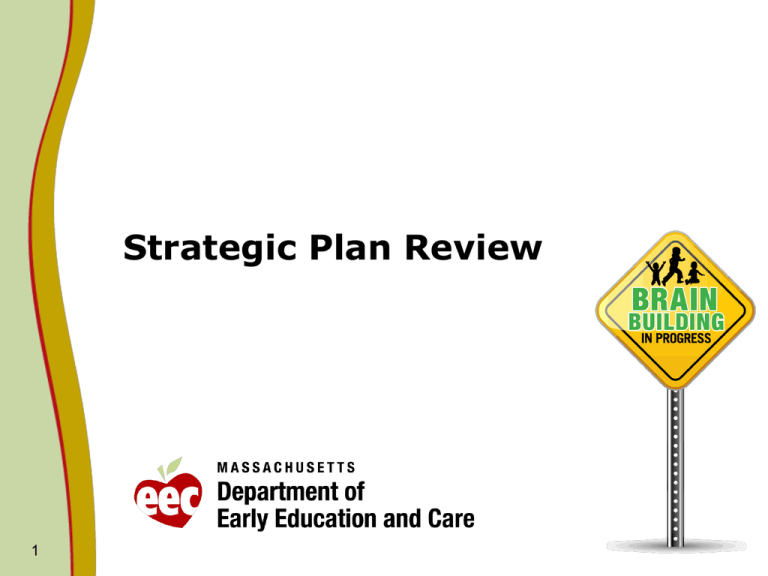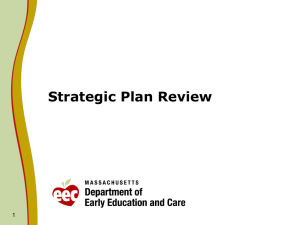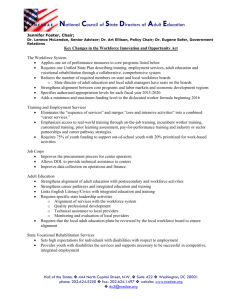Strategic Plan Review
advertisement

Strategic Plan Review 1 Process 2 Planning and Evaluation Committee will be discussing 2 directions per meeting. October meeting- Finance and Governance November meeting- Finance and Governance December meeting- Standards, Accountability, Regulations and January meeting- Workforce, Informed Families & Public, and Early Education and Care and Kindergarten to 3rd Grade Linkages 7 Areas Finance Governance Standards, Assessment, and Accountability Regulations Workforce and Professional Development Early Education and Care and Kindergarten to 3rd Grade Linkages Informed Families and Public 3 FINANCE 4 Finance 5 To develop a financing strategy for a comprehensive system of early education and care and out of school time for all children based on established Department of Early Education and Care standards. Finance The Department will fund high quality programs and initiatives which impact growth and development of children, families, educators, programs and communities. 6 High quality programs and activities will be defined by the Department such as QRIS, and researched based literacy initiatives. Finance The Department will seek funding from multiple funding sources for the early education and care and out of school time system. Create a funding plan including priorities, strategies, and timelines beyond the current boundaries of state funding for the early education and out of school time system. Establish a business case for investment in early education and care and out of school time. Establish a public/private partnership funding mechanism to serve high needs children not eligible for CCDBG for continuity or entry. 7 Finance The Department will incentivize programs to reach and maintain Department of Early Education and Care standards. Establish a process based on a model to provide annual quality grants to incentivize programs to reach and maintain a validated status in QRIS. Biannually EEC will establish a formula for determining a rate increase to providers to be provided annually. 8 Finance The Department will develop a financial strategy that prioritizes and supports continuous improvement and advancement of the early education and care system. 9 Develop implementation of the June 2012 Board vote to increase the reimbursement for transportation to support one adult monitor on all vehicles who transport infants, toddlers and/or preschoolers. All line items will have a transparent funding formula. Finance The Department will fund research for the purpose of evaluation, program development and advocacy. All line items will invest in research and evaluation related to population related goals and program evaluation. In addition, the Board will establish an investment percentage by September each year. Establish a mechanism to collect data on all children with parental consent who are in licensed early education and care, out of school time, Head Start and public school preschools beginning with those receiving any state funding to monitor the State’s reach for children birth to 8. 10 Finance The Department of Early Education and Care will develop strategies to have maximum reach to all children in Massachusetts birth to age 8. 11 EEC’s financial assistances policies as well as our community based initiatives will support strengthening families approach. GOVERNANCE 12 Governance 13 To develop policy directions for the comprehensive system of early education and care and out of school time in Massachusetts. Governance Maintain and/or develop opportunities for continuous input and active engagement from individual board members. 14 Conduct an annual Board survey Include Board members on advisory groups. Coordinate a Board retreat Update the orientation handbook for Board members. The Department and Board Chair will provide regular opportunities for input on meeting agendas. Governance Intentionally integrate EEC into other systems that impact growth and development. To have a governance structure that has access to the theory, practice, and reflection of multiple professions that contribute to growth and development. Develop guidelines on how to partner with other state agencies or institutions to work on areas of common interest. 15 STANDARDS, ASSESSMENT AND ACCOUNTABILITY 16 Standards, Assessment and Accountability 17 To provide a foundation for a comprehensive system of early education and care and out of school time built upon program standards and early learning standards. Standards, Assessment and Accountability Promote the utilization of valid and reliable evidence-based assessment tools. Field has the skills, knowledge and ability for reliable utilization of evidenced-based assessment tools. Seek opportunities to measure and inform effective practice as it relates to standards. Standards reflect effective practices, programs and alignment across the system. Monitoring tracks program performance and results based on standards. All licensed programs are in QRIS level 1 by 2015. All license-exempt programs receiving EEC funding are in QRIS level 1 by 2014. 18 Standards, Assessment and Accountability To utilize data, planning and evaluation to inform a comprehensive system of early education and care and out of school time. Alignment of Early Learning Standards (from birth to kindergarten). Alignment of comprehensive system of early education and care from birth to kindergarten. To generate a feedback loop that informs policy, research and practice that supports positive outcomes for programs, children and families as articulated by the standards. 19 Determine what the impact is on programs, children and families. REGULATIONS 20 Regulations 21 To develop regulations that articulate the rights and allocate the responsibilities across the systems of early education and care, out of school time, adoption, foster care, and residential. Regulations Regulations are current and reviewed as determined by national standards. Review and update our regulations on or before 2015 based on current research and practice. Develop a matrix of terms across multiple regulatory tools and, when appropriate, select terms that will be used consistently. System of communication with the field regarding changes in regulations. Develop the regulations to support a Birth to 8 educator license. 22 Develop a packet that walks educators through the process. Regulations 23 To approve programs of study for the Birth to 8 licensure. To conduct a full review of our current legislative mandate and revise as necessary. Regulations focused on health and safety. WORKFORCE AND PROFESSIONAL DEVELOPMENT 24 Workforce and Professional Development 25 To facilitate a system that prepares an early education and care workforce who can engage with children and families to support their growth and development in all domains. Workforce and Professional Development 26 To support the development of the workforce To develop and articulate standards for training of workforce. To promote or support Implementing systems that support effective practice for educators To provide professional development and to provide support for professional development Workforce and Professional Development 27 Workforce should have knowledge and skills To provide professional development and to provide support for professional development Workforce should have knowledge and skills To develop standards for the workforce as it relates to the development of children. EARLY EDUCATION AND CARE AND KINDERGARTEN TO 3RD GRADE LINKAGES 28 Early Education and Care and Kindergarten to 3rd Grade Linkages 29 To create policies and practices that ensure the alignment of structures that support child development from birth through grade 3 across all developmental domains, with a focus on early literacy, numeracy, and social/emotional development. Early Education and Care and Kindergarten to 3rd Grade Linkages 30 STEM standards. Intentional focus on literacy and numeracy. Strategic direction of what it means to be Birth to 8. The development of policies and practices that support birth to 8 infrastructure, joint professional development. Early Education and Care and Kindergarten to 3rd Grade Linkages the continuum of programs and services that child’s growth as measured by the child’s 3rd grade success. for aligning strategic activities that support the growth and development of children from birth to 8 infrastructure as measured in 3rd grade success. 31 joint professional development. Early Education and Care and Kindergarten to 3rd Grade Linkages 32 INFORMED FAMILIES AND PUBLIC 33 Informed Families and Public 34 To communicate regularly with families and the public about the essential conditions for positive growth and development of children with respect for culture, language and other aspects of diversity of those constituencies. Informed Families and Public External and internal communication strategy to external and internal stakeholders Increase the visibility of the efforts that lead to growth and development of children. The whole child Joint statement of communication 35 Informed Families and Public 36 Develop a strategic communications plan Brain Building in Progress Communications to inform families, providers and the public. Informed Families and Public 37 Next Steps 38 Board Votes on Strategic Plan at March 12 Board meeting.









